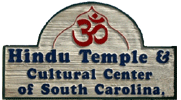Hindu Temple of South Carolinaॐ नमो भगवते वासुदेवाय Om Namo Bhagawate Vasudevaya |

|
Menu
Knowledge Center
Hinduism is based on "the accumulated treasury of spiritual laws discovered by different persons in different times." The scriptures were transmitted orally, in verse form to aid memorization, for many centuries before they were written down. Over many centuries, the teachings were refined by other sages, and the canon expanded. The majority of the sacred texts are composed in the Sanskrit language. Sanskrit continues to be used today in religious and literary settings. The scripture are collectively referred to as Shastras and are classified into two classes: Shruti and Smriti.
Shruti: Vedic literature
The Rig Veda is one of the oldest religious texts. Shruti (lit: that which has been heard) refers to the Vedas (वेद, Knowledge) which form the earliest record of the Hindu scriptures. While they have not been dated with much certainty, even the most conservative estimates date their origin to 1200 BCE or earlier.
Hindus revere the Vedas as eternal truths, revealed to ancient sages (Ṛṣis) through meditation. Many of these sages were women, called Ṛṣikās. Most Hindus do not associate the creation of the Vedas with a God or person. They are thought of as the laws of the spiritual world, which would still exist even if they were not revealed to the sages.
There are four Vedas (called Rik-, Sāma- Yajus- and Atharva-). The Rigveda is the first and the most important Veda. Each Veda is divided into four parts: the primary one, the Veda proper, being the Samhitā, which contains sacred mantras in verse. The other three parts form a three-tier ensemble of commentaries, usually in prose, which are historically believed to be slightly later in age than the Samhitā. These are: the Brāhmanas, Āranyakas, and the Upanishads. The first two parts are called the Karmakāṇḍa (the ritualistic portion), while the last two form the Jñānakāṇḍa (the knowledge portion).
The Upanishads focus on spiritual insight and philosophy whereas the Vedas focus on rituals. These texts constitute a major portion of the Jnāna Kānda, and contain much of the Vedas' philosophical teachings. The Upanishads discuss Brahman and reincarnation. While the Vedas are not read by most lay Hindus, they are yet revered as the eternal knowledge whose sacred sounds help bring spiritual and material benefits. Theologically, they take precedence over the Smriti.
Smriti
The most notable of the smritis are the Itihāsa (epics), which consist of the Mahābhārata and the Rāmāyana. Bhagavad Gītā is an integral part of the epic Mahabharata and one of the most popular sacred texts of Hinduism. It contains philosophical sermons told by Krishna, an incarnation of Vishnu, to the Pāndava prince Arjuna on the eve of a great war. The Bhagavad Gītā is described as the essence of the Vedas.
Also widely known are the Purānas ("ancient histories"), which illustrate Vedic ideas through vivid narratives dealing with deities, and their interactions with humans. Other key texts are the Devī Mahātmya, the Yoga Sūtras, the Tantras as well as the Mahanirvāna Tantra, Tirumantiram and Shiva Sutras. Another important set of scriptures with a more sectarian nature are the Hindu Āgamas, which dedicate to rituals and worship associated with Vishnu, Shiva and Devī. A more controversial text, the Manusmriti or "Code of Manu", is a prescriptive lawbook which epitomizes the societal codes of the Brahminical caste system.
Most Hindu scriptures, especially the epics and Puranas, are not typically interpreted literally and more importance is attached to the ethics and the metaphorical meanings derived from them. Hindu exegesis leans toward figurative interpretations of scriptures rather than literal ones.
